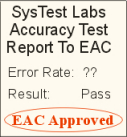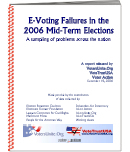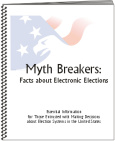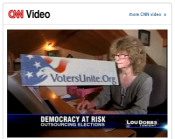Federal Certification Test for Vote-Counting Accuracy Cannot Determine the Error Rate of the Equipment
by Ellen Theisen. March 21, 2009
permalink
We live in a world of complex computerized systems -- medical equipment such as MRIs and CAT scans; flight control software; an automotive fuel injection system; the databases that store, retrieve, and collate data. All these systems undergo stringent testing.
|

|
The primary purpose of any testing of computerized systems is to show either that the system works as designed or that it doesn’t. If the system does not work as designed, then the test results are expected to provide information on the nature, and perhaps the cause, of the defective behavior.
Using these criteria, this report evaluates one specific test -- a test designed to confirm or refute that a specific computerized vote-counting system meets the accuracy level required by federal law. The details that follow contain many numbers and many technical details, but the discussion centers on a single, simple question: did the test, which was approved by the federal agency tasked with certifying voting equipment, provide evidence that the accuracy requirement was met, or did the test provide evidence that the accuracy requirement was not met?
As the author demonstrates in this specific instance, the answer is: the test provided neither. The test, which was designed by a federally-accredited test lab for the sole purpose of testing the accuracy of the vote-counting equipment, cannot prove whether or not the system accurately counts votes, nor can the test yield any measure of the accuracy rate.
The author wants the reader to understand that such testing provides false assurance that a federally-certified vote-counting machine meets the accuracy requirements of federal law.
Read the report (pdf)
The EAC Need Not Continue Violating Federal Law
by John Gideon and Ellen Theisen. January 5, 2008
There can be little doubt that, of the issues springing from elections held since President Bush signed the Help America Vote Act of 2002 (HAVA), two are among the most significant. Those issues are failures of voting systems to meet the HAVA mandates for accuracy and accessibility and the confusion over the proper use of provisional ballots.
The states should have been able to look to the federal Election Assistance Commission (EAC) for guidance on both issues, but the EAC has failed to give the necessary Assistance, thus failing to fulfill duties assigned to the agency by federal law.
Now the EAC is proposing to extend its dereliction of duty for another two years. The result will be the publication of these important guidelines a full eight years after HAVA was enacted. The delay is inexcusable and intolerable, and the cost to American elections, on many fronts, is nearly incalculable.
More ...
Counting the Vote in Four Paper Ballot States
The Public Double-Checks the Count in Humboldt County, CA
The Election Transparency Project (ETP) is introduced here, and you find out more by clicking on the links provided on that page. This project may be the key to using computers to INCREASE public vote-counting, rather than to decrease it.
The 2008 Minnesota Hand Recount
Read the blog with reports from non-partisan recount observers who were spread across the state to observe the recount of the U.S. Senate contest.
Compliments of Citizens for Election Integrity MN. Read about the recount process in Minnesota.
An Inside Look at Vote-Counting in Oregon
Watch a 13-minute video documentary of the county elections office in Washington County, Oregon on November 4, 2008, covering the internal process that happens in a vote-by-mail state.
Compliments of K. Shawn Edgar
Vote-Tallying is "private SoS business" in New Hampshire
When citizens tried to observe the central tabulation of election results, the NH Secretary of State told them they could not enter the "nonpublic" rooms where the tally was occurring and gave them a "warning" about videotaping events where the central tabulation was taking place.
Watch the 10-minute video, compliments of NH Protect the Count.
Federal Vote-Counting Accuracy Mandate Is Ignored
Violations abound, but no federal action is taken
by Ellen Theisen. Last updated December 5, 2008
permalink
The Help America Vote Act of 2002 (HAVA), Section 301(a)(5), requires that the vote-counting error rate of each voting system used in federal elections must comply with the 2002 Voluntary Voting Systems Standards. UPDATE, May 5, 2008. It has come to our attention that the 1/500,000 error rate previously quoted here applies to the testing process. For operation in an election, the allowable error rate is 1 error in 10,000,000 ballot lines (0.00001%).
Here are some examples of voting system error rates logged in elections since HAVA was enacted, yet no federal agency has taken action to stop the use of these systems. In fact, all these systems are still in use in the United States.
|
Maximum legal error rate:
|
0.00001%
|
Diebold (Premier) GEMS 1.18.19 error rate:
Humboldt County, CA. Nov. 2008
64,161 ballots; data for 197 ballots deleted from system.
|
0.31%
|
Sequoia 400C optical scanner error rate:
Palm Beach County, FL. Sept., 2008
102,746 ballot; 756 errors in 1 contest, with 2 ballot lines.
|
0.37%
|
ES&S InkaVote Plus ballot-marking error rate:
Los Angeles County, CA. June, 2008
1 ballot; 8 errors in 13 contests, with 35 ballot lines.
|
11.43%
|
ES&S iVotronic (e-vote) error rate:
Faulkner County, AR. East Cadron B. May, 2008
57 ballots; 57 errors in 1 of 5 contests.
|
11.11%
|
Sequoia AVC Advantage (e-vote) error rate:
Camden County, NJ. Pennsauken Dist. 6. Feb. 2008
One machine, 21 votes, 20 ballots.
|
0.68%
|
Sequoia AVC Advantage (e-vote) error rate:
Bergen County, NJ. Engl.Cliff.Dist 4. Feb. 2008
One machine, 106 votes, 105 ballots.
|
0.12%
|
Premier (Diebold) GEMS v.1-18-24.0 error rate:
Butler County, OH. March 2008
105 entire ballots uncounted.
|
0.08%
|
ES&S Optech IIIP Eagle scanner error rates:
Milwaukee City, WI, Ward 43. Nov. 2004
Milwaukee City, WI, Ward 44. Nov. 2004
Milwaukee City, WI, Ward 98. Nov. 2004
Entire ballots uncounted in each case.
|
0.43%
0.10%
0.43%
|
Diebold AccuVote OS scanner error rate:
Germantown Village, WI, District 1. Nov. 2004
Eleven entire ballots uncounted.
|
0.11%
|
Hart InterCivic Ballot Now scanner error rate:
Yakima County, WA. Precinct 3301. Nov. 2004
One machine, all five contests in one column uncounted on 24 ballots.
|
0.18%
|
Sequoia AVC Edge touch screen error rate:
Bernalillo Co, NM. Precinct 558-early voting. Nov. 2004
More votes than voters (phantom votes) in all 37 contests.
|
29.49%
|
Sequoia Optech 4C scanner error rate:
Dona Ana Co, NM. Precinct 106-absentee. Nov. 2004
More votes than absentee voters in 16 of the 22 contests on the ballot. (For the precinct as a whole, a total of 65 more presidential votes than the number of voters registered in the precinct.)
|
23.57%
|
Many other news stories tell of equally shocking error rates. Though we have not calculated the error rate per ballot line (choice on the ballot), it's clear that these miscounts are far beyond the legal limit of one error in 10,000,000 ballot choices.
For example:

|
Phillips Co, AR. 2006. 432 of 2,011 ballots had "mistakenly been counted as Republican ballots, effectively nullifying them." (Thanks to ES&S programming of the iVotronic touch screens.)
|

|
Pottawattamie Co, IA. 2006. A machine count of the absentee ballots showed Sciortino 79, Duran 99; but a subsequent hand count gave the correct count: Sciortino 153, Duran 25. (Thanks again, ES&S.)
|

|
Johnson Co, KS. 2002. Results were misreported in six races. "The system miscounted hundreds of votes, and a re-count was ordered." (Diebold admitted it was a software error.)
|

|
Sarasota Co, FL. 2006. ES&S touch screen voting machines reported 18,000 fewer votes than voters in a US Congressional contest won by less than 400 votes. Wait! My mistake. It's impossible to tell whether this was a miscount or not since the electronic evidence has long since vanished into thin air and cannot be recovered.
|
The list goes on and on and on ... Every election, federal law is being violated in hundreds, maybe thousands, of polling places, and no federal agency takes action.
Worse yet, democracy is being violated.
Furthermore, HAVA Section 301(a)(3), which requires that each poll site provide a means by which voters with disabilities can vote privately and independently, has been the driving force behind the widespread purchase of equipment that DOES NOT COMPLY with the very law it purports to satisfy.
The official report from the California "Top to Bottom Review" of voting systems shows that much of the "accessible" equipment doesn't even meet common-sense standards, and stories from poll sites are heart-wrenching. Yet, the fact that "accessible" equipment is inaccessible is being ignored by virtually all officials. Certainly no action has been taken.
Voting system vendors are taking billions of tax-payer dollars and, in return, giving us inaccurate, inaccessible, unauditable, unreliable voting equipment that counts our votes in secret.
You Can Take Action. It's time to call for accountability in the machinery of our electoral system. Please sign the petition in support of VoterAction's call for Congressional investigations into blatant and destructive commercial fraud in the electronic voting machine industry.
E-Voting Failures in the 2006 Mid-Term Elections
A sampling of problems across the nation
The 2006 mid-term election revealed that the promise of easier voting, more accurate tallies, and faster results with electronic systems has not been fulfilled.
|
This account of the November 7, 2006 election draws on incidents reported by pollworkers, voters, and the media.
In all, we looked at 1022 reports of problems associated with electronic voting equipment from 314 counties in 36 states.
Read the report
View the incident data
|

|
Prepared by VotersUnite, VoteTrustUSA, Voter Action, and Pollworkers for Democracy.
Pollworker reports provided by Pollworkers for Democracy.
Voter incident reports provided by Election Protection Coalition and Voter Action.
Media reports collected by VotersUnite.Org.
Myth Breakers: Facts about Electronic Elections
2nd edition - designed for County Officials
|

 Download free
Download free
|
Information is power. Learn the facts.
Myth Breakers...
- Corrects HAVA misconceptions
- Describes HAVA-compliant alternatives to DREs
- Gives general pricing information
- Speaks about myth vs. misinformation
The second edition includes...
- Malfunctions from the 2004 General Election
- More about testing and certification
- Details about software complexities

|
|
Myth Breakers is a tool for citizen activists. Myth Breakers will enable you to speak with confidence about the issues. Then ...
Spread the Truth! Deliver "Myth Breakers: Facts about Electronic Elections" to your local election officials and legislators. Give them the information they need to make wise decisions.
Participants have confirmed that Myth Breakers (first and second editions together) have been delivered to thousands of election officials and legislators.
Do your local and state officials have the facts?
|
|











